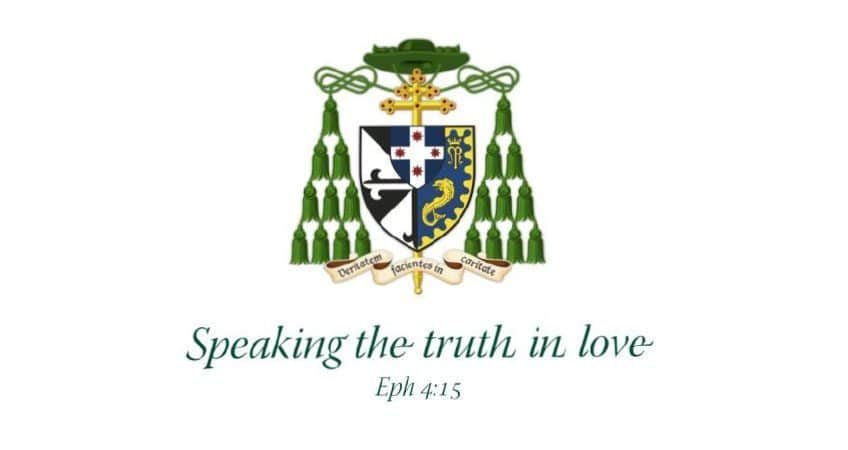Homily for the Ritual Mass of the Dedication of an Altar and Blessing of Other Liturgical Furnishings

Holy Family Church, Menai, 11 September 2022
The annual gala at New York’s Metropolitan Museum of Art has been dubbed the “Oscars of Fashion.”[1] The event sees A-list celebrities, fashion royalty, the uber wealthy and politicians rubbing shoulders as they vie for the paparazzi’s attention by dressing in ornate themed costumes. Controversially, in 2018 the theme selected by the organisers was: Heavenly Bodies: Fashion and the Catholic Imagination.[2] Attendees dressed in outfits inspired by angels’ wings, religious habits, even liturgical vestments. (I do not recommend this to the fashion-conscious people of Menai!)
It’s obvious that Catholic faith has significantly influenced music, architecture, and the arts. But as curators of this exhibition explained, the converse is also true: material Christianity—in art, architecture, fabrics and furnishings—has significantly influenced the Catholic imagination, beliefs and practices, and these in turn our whole civilisation.[3] Catholicism is not a disembodied idea or ‘spirituality’, but rather a divine Spirit, Word or ‘Logos’ incarnate in the Man Jesus, and beliefs as much impressed by as expressed in physical people, spaces and activities in the material world.
Which helps explain why Catholics take churches so seriously and their altars, fonts, tabernacles, lecterns and statues. We are not the first to do so. Australia’s First Nations people regard sacred sites and objects as very important. So, too, our Jewish ancestors counted the Temple as the place where God’s shalom or divine presence, grace or peace abided. But before they settled in Jerusalem, they had altars in other places: our first reading records the consecration of a monumental stone pillow as an altar of God by pouring oil over it; this marked the whole area a holy site, “the house of God and gate of heaven”; and there Jacob could dream dreams, hear God’s voice, and receive God’s blessing (Gen 28:11-18).
Altars are a recurring motif in the Old Testament: they feature in the stories of Noah, Abraham, Jacob, Moses and Aaron, of Joshua, Gideon, Saul, David and Solomon, of Elijah and Nehemiah.[4] The God of Israel was in general pleased by the dedication of altars to Him, and the worship offered there; He was decidedly unimpressed when His altar was defiled or rival altars erected!
But aren’t Christians and their understanding with God different? Following the teachings of Christ about His body being the real Temple (Jn 2:21) and of St Paul about our bodies being (in turn) holy places (1Cor 6:19), haven’t we outgrown the primitive religions with their sacred sites, holy rocks and ritual sacrifices? Isn’t God’s earthly dwelling now the Christian soul? Haven’t we outgrown altars and the like?
Well, look at Jesus. Many crucial events in His life happened against the backdrop of the Temple: His Presentation as a baby, His Finding as an adolescent, His cleansing the Temple as an adult, His praying and preaching, healing and prophesying there, His Last Supper close-by while the Paschal lambs were being sacrificed there. His disciples summed up this enthusiasm with the Old Testament aphorism “Zeal for God’s house consumes me” (Jn 2:17; cf. Ps 69:9). Jesus was on fire for this sacred place, like incense on a brazier.
But what makes a church a sacred building, an altar a table of offering? Is it the grandiose architecture, spooky atmosphere, hierarchical layout, archaic furnishings, fine materials, bells and smells? Or the moods and emotions all this evokes? No: what makes a church building a sacred space or an altar a sacred object is precisely the liturgical act of dedication, and then the acts of liturgy—of divine service—that take place around it. In our epistle St Paul reminds the Christians of Corinth and Menai that altars only serve their purpose if fitting worship is offered, ordered towards the one true God (1Cor 10:16-21). Similarly, in our Gospel, Jesus favours bringing offerings to the altar, but directs that, before doing so, we ready ourselves by being reconciled to God and others (Mt 5:23-24). Mass starts with Confession.

Shortly, we will witness the elaborate rites of consecration of a new altar. One way of understanding what’s going on is to compare it with a baby or adult becoming a Christian. We began Mass by baptising the altar, so to speak. Then, like the newly baptised, the altar is instructed from our new ambo through the mystagogia of readings and preaching: Altar, are you listening?
Next, we will join this stony catechumen in making baptismal promises and ask the saints to help us keep them. We will then pray the ancient prayer of consecration of the altar, a beautiful prayer, worthy of our fullest attention, and like the prayers of parents and parishioners for the newly baptised: here we recall our family history and express our hopes for this child’s future. After that I will anoint the altar with the sacred chrism, the oil of salvation, just as Jacob did in our first reading, and as we do the crown of a newly baptised baby. Then, like the just-Christened, we will clothe our altar in white and light it with candles. Only after all these rites have been completed will I give this altar the Kiss of Peace, for only then will it be a Christian and only then will it be fit to celebrate its first Holy Eucharist. So this is our baby altar’s Baptism, Confirmation and First Communion Day!
People of Menai, you are rightly proud of your new-look church. It has been transformed into something beautiful for God. Now its centrepiece that is the altar will be fully initiated into the Church. As we witness natural materials made into holy objects, we recall that we too are natural materials transformed by faith and sacraments. Like the new lectern, we must be living tables of God’s word. Like the new font, we must bring forth new Christians into our world. Like the new tabernacle, we must receive Christ’s Eucharistic Body. Our hearts too, must be altars, not of stone but of flesh, and then not just of flesh but of spirit also, where Christ is honoured, given and received. So may our senses and imaginations, hearts and minds be rendered fitting for divine service, and our very lives made into liturgies also!
[1] https://www.newsbytesapp.com/news/lifestyle/met-gala-facts-theme-how-to-watch/story
[2] https://www.abc.net.au/news/2018-05-08/met-gala-fashion-catholicism-collide-in-new-vatican-exhibit/9737914
[3] https://www.vogue.com/article/met-gala-2018-theme-heavenly-bodies-fashion-and-the-catholic-imagination
[4] Gen 8:20; 12:6-7; 35:7-17; Ex 17:15; 20, 24; 32:5; 40:9; Josh 8:30-35; Judg 6:24; 1Sam 14:35; 2Sam 24:18-25; 1Chr 21:18-26; 2Chr 8:12.
Introduction to the Ritual Mass of the Dedication of an Altar and Blessing of Other Liturgical Furnishings
Holy Family Church, Menai, 11 September 2022
Welcome to Holy Family Catholic Church Menai for the Ritual Mass of the Dedication of an Altar and for the Blessing of the new baptismal font, tabernacle, lectern, presidential chair, oil repository and statues. In recent weeks I have met several Menai parishioners who have excitedly bragged to me about how beautiful their church is as a result of its renovations and who were looking forward to showing it off to me! Well, let me say you were right: it is a most impressive facelift, indeed more than a facelift, a spiritual uplift, that you have achieved here.
Today we mark the passing of Elizabeth II, Queen of Australia and her other dominions and territories, and give thanks for her life. She was a model of public service and dedication to duty, of calm and steadfastness in adversity, and of leadership and comfort for her people. She often spoke of her love for Australia and Australians reciprocated. We also recall that the Queen was a woman of faith, who loved Christ as the true King of kings, attended Church and prayed regularly, articulated her faith in her Christmas messages, treated all she met with Christian courtesy, and understood her role as a religious vocation. Today we pray God grants eternal rest to this servant and comfort to King Charles and the royal family during this time of mourning.
I salute concelebrating with me the master-planner of the renovation works here at Holy Family, Parish Priest Fr Mani Malana MSFS, whose forty years of priesthood (so far) we acknowledge with gratitude. I also recognise concelebrating with us the former Assistant Priest part-responsible for the renovations Fr Daniele Russo, with Mons Brian Rayner, Fr James McCarthy and Fr Ravi Muvvala.
I extend a special welcome to those who had a hand in the beautiful renovations, including architect Michael Suttie, builder Christian Abou-Rizk and PPC President Peter Mauch with the council members. To everyone here today on this joyous occasion, a very warm welcome to you all!

